
Diving the Galapagos Islands– A Dream Fulfilled
Or – It’s all JudyG’s Fault!

I think there's a rule that all Galapagos trip reports have to start with a photo of Darwin's Arch
It all started a few years ago during a rather slow day at work when I downloaded a slideshow with the rather intriguing title of "Whacked by a Whale Shark" posted by JudyG (boss, I swear it was during my lunch hour). I sat mesmerized as I watched the images thinking to myself "I have got to do this trip". As soon as the show finished, I burned a copy to CD to show to my wife and dive buddy, Kriss.
Like many long time divers, we had often talked about a trip to the Galapagos Islands, but with the expense, logistics, and the reportedly tough diving conditions (we are major warm water wimps), we never got around to seriously pursuing this particular dream. That all changed when I arrived home and dropped the CD in her computer and said "you have to watch this". At the conclusion, Kriss turned to me said "We are going" – and planning ensued.
Getting There
One of my life’s goals has been to dive with whale sharks – the largest fish in the seas. Unfortunately, we have been skunked on our previous attempts to see these magnificent creatures, so it was a foregone conclusion that our Galapagos trip would have to be during peak whale shark season. Of course that’s when everyone wants to go, so it not unusual to have to wait two to three years to book one of the two Aggressor boats. We found a couple of open slots during our time frame only a bit over a year away in October 2006 that featured a Jim Church School of Underwater Photography Photo Expedition with a $350 premium over the base charter rate of $3,095. I figured, what the heck, Kriss, being a non photographer might be bored to tears, but my photo skills need all the help they can get and the trip was booked.
Air was a bit more challenging as we had enough frequent flyer miles for only one of us. In order to save a hundred bucks, Kriss’ FF ticket was booked through Delta via a code share with Continental, while mine was booked directly with Continental. Over the course of the next year our flights were changed multiple times, and despite the tickets being "linked", there was absolutely no coordination between the carriers, and the routing, layovers and travel dates were way less than optimal. That's a mistake we won't make again. On the positive side, we were able to score bulkhead or emergency row seats on every leg except for the return AeroGal flight from San Christóbal to Guayaquil.
When our much anticipated departure date finally arrived, we had a smooth and uneventful flight from Cincinnati to Atlanta and up to our approach into Quito, Ecuador when the pilot aborted his first landing attempt due to bad weather and proceed to circle for about a half hour. He finally announced he was going to make one more attempt to land and if unable to do so, he would divert the flight to Guayaquil. Thankfully, the clouds parted and we were finally able to land. After breezing through immigration and customs, we caught a $5 cab ride to the delightful Hotel Café Cultura, which would be our lodging for the next couple nights. Highly recommended if your trip includes a stay in Quito, with way more character and charm than the nearby sterile Hilton hotel.

Interior of Iglesia de la Compañia. Scanned from a postcard as photography is not permitted. One and a half tons of gold were used in the construction.
We spent the next day playing tourista with a guided tour of Quito’s old town. If churches are your thing, Quito is your town. We finished with a trip to Mitad del Mundo at the equator. We found the ethnographic museum located within the monument definitely worth the time.
Early the next morning it was back to the Quito airport where we met the Aggressor rep who briefed us, gave us our AeroGal tickets for the plane ride to San Christóbal where we would meet the Aggressor I, and assisted us with checking in.
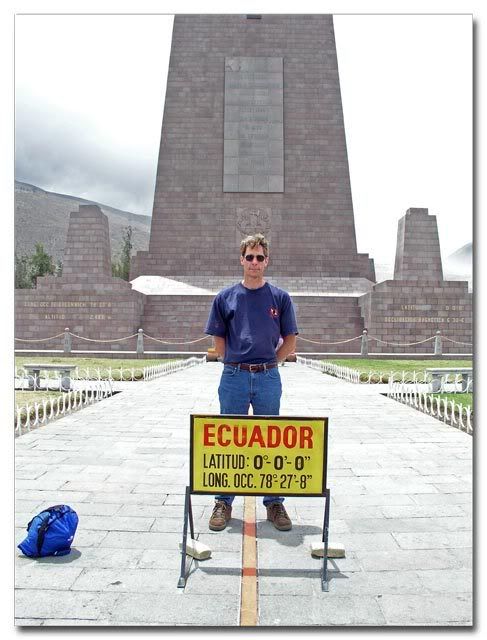
Tim playing tourist at Mitad del Mundo
After clearing security and entering the waiting area we met Mike Mesgleski (Mike M) from the Jim Church School who would be our photography instructor for the week and some of the other guests. We had lots of time to get to know one another as our flight to Guayaquil and San Christóbal was delayed for a couple of hours due to weather (are you sensing a pattern here?). Upon arriving at San Christóbal in the Galapagos, we were met by Walter and Nelson, our divemasters for the week, and were directed to a tour bus for the short ride to the harbor. We then boarded the Zodiac – OK, I’ll get in the spirit and call it a "panga" here on out, for the ride to the Galapagos Aggressor I (GA I).
The Galapagos Aggressors
The Galapagos Aggressors I and II are essentially identical craft built in 1992 and refitted in 2003. They are 100 ft.(30 meters) vessels with a beam of 22 ft.(7 meters) and carry a maximum of fourteen passengers in seven staterooms. The upper deck cabins have two twin beds that can be pushed together to form a queen bed for couples, or separated for roomies. Cabins were fairly spacious by liveaboard standards with lots of storage space. Baggage, once unpacked, is stored in an engineering space until the end of the trip. Each room has a flat panel TV and cd/dvd player. The ensuite heads have a standard style toilet, stall shower with lots of hot water and decent water pressure, sink and hair dryer. BYO shampoo. The tap water in the head is not potable, but a fresh water container and a couple of bottled waters are refreshed daily, and can be topped up at anytime in the salon. Complimentary water bottle carriers, eyeglass straps, and ear plugs in case the engine noise keeps you awake, are provided for each passenger.
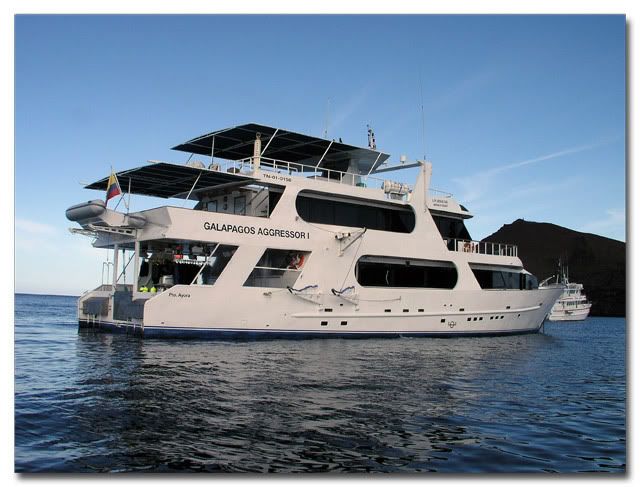
Galapagos Aggressor I
The salon and dining area was spacious and also well appointed with a wide screen flat panel TV and a selection of DVD’s and CD’s. Kriss’ only complaint was it was obvious the crew of ten were all male as there were no good chick flicks.
The dive deck was spacious with individual storage space for each passengers' personal items under each seat. Each diver is provided two AL 80 tanks. In the rare event the crew can’t fill your tank in time for the next dive, simply switch your BC to your spare tank. This only happened once on our last day of diving due to a 30 minute surface interval. Three rinse tanks are provided, two of which are dedicated to cameras. Two camera tables, with lots of storage space below, are located just forward of the dive deck, as is a good size charging station , coffee dispenser, towel warmer and head. Being a photo expedition, things were a bit crowded on the tables. Many of divers had housed DSLR rigs with multiple strobes, so this was to be expected.
All of the divers and the two divemasters were diving on Nitrox (a very reasonable $100 surcharge). Given that our poor backup air computers went into gauge mode due to violating a mandatory deco obligation after our first dive at Darwin’s Arch, and stayed there for the remainder of the week, this was a good thing. O2 analyzed at a consistent 33% and a fraction and air fills were an unvarying 3000 to 3200 PSI (207 to 221 Bar) with nary a short fill all week.
The dive deck has two hot water showers and multiple infrared heaters overhead – a very nice touch. As soon as you peeled off your wetsuit, a crew member was always there to drape a warm towel over your shoulders and hand you a cup of hot chocolate if desired. Hot snacks were also provided after most dives.
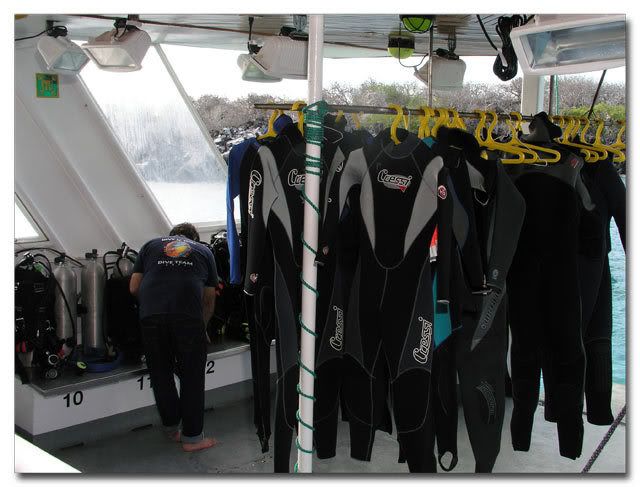
The Dive Deck
A small hot tub is located just forward of the pilot house, but only contained enough warm water to barely cover our legs, and it didn't see much use. The top deck is a partly covered sun deck with four lounge chairs and some deck chairs.
Food during the week was also very good. Breakfasts were cooked to order off of a menu. Lunches were typically served buffet style, while the excellent and varied dinners were served by the ever smiling steward, Francisco. We are what the Wall Street Journal calls "flexitarians", or mostly vegetarian, but will eat meat occasionally. The meals contained enough options for us to indulge our proclivity without having to make any special requests. Soft drinks, a decent Ecuadorian beer, Cervesa Pilsner, and some very good Chilean wines are included. Of course, consuming alcohol ends your diving for the day.

The ever smiling Francisco presenting one of his daily carvings - an Equatorial Penguin
Twelve passengers were on board during the week. Another couple were booked, but had to cancel at the last minute due to illness. Thank goodness they had trip insurance. The group was a very experienced bunch of divers (as well they should be) and a fair number of us were DM's, AI's or instructors. They were a great bunch to dive with, but due to a nasty outbreak of gastrointestinal illness, the details of which I will spare you, many had their dive week curtailed. According to passenger, physician and victim, Mike, the illness was most likely viral in nature, had a relatively short incubation period, and was likely brought on board by one of the passengers. Nine of twelve passengers were hit while on board, only Mike M, Kriss, and I were spared. For the most part it seemed to pass in twelve to twenty four hours, but one passenger was particularly hard hit and missed thirteen of nineteen offered dives. Thankfully she did get in one dive at Darwin and did have a whale shark encounter. The crew responded admirably, frequently sanitizing the lower deck and caring for those who were stricken.
Overall, we found the GA 1 to be a beautifully appointed and excellently maintained dive vessel. The only maintenance problems we encountered during the week were a faulty DVD remote control and a cabin air conditioner that died one afternoon. Both problems were quickly and unobtrusively dealt with.

Beware the Yellow Puffer
Enough Yammering Already - What About the Diving?
Or Follow the Yellow Tank
As our trip approached, I'll admit I was getting a little apprehensive about the diving. Sure, I have dived cold water before (and don't particularly enjoy it); and low vis; and in ripping currents; and with large predators; and I have done my share of hanging out in the blue on safety stops, but never all on the same dive. As it turns out, the conditions we had were not nearly as bad as I had feared. Temperatures were warmer than usual, and currents were relatively mild. Certainly no Caribbean cakewalk, but well within our skill level.
Prior to the start of our diving, everyone was provided with a collapsible bungied dive flag to use in lieu of a safety sausage. The idea being that the rigid dive flag is more visible in strong winds than a safety sausage. Everyone who didn't already carry a "Dive Alert" signaling horn was provided one. The GA I also has ten Emergency Position Indicating Radio Beacons (EPIRB's) that were distributed among the buddy teams. Lucky me wasn't able to score one, so I had a particular incentive to stick close to my dive buddy. In the event you surface and can't be located by one of the Zod 'er pangas or the mother ship, you deploy the EPIRB which sends out a radio signal that can be picked up by the boats. While a few dive flags were deployed during the week, no more drastic signaling measures were needed.
The divemasters alone use brightly painted yellow tanks, and you are advised that if you want them to spot for you, "follow the yellow tank". If not, hasta luego. The only other advice we were given was "it's a good idea to head up for your safety stop when you hit 600 PSI (41 Bar). No wimpy "back on the boat with 500 PSI" (34 Bar) here. If you need a DM to act as a mother hen, this is not the place for you.
Our first dive was the checkout dive at Isla Lobos. This was one of two dives made directly from the dive deck on the GA I. All other dives were from the two pangas. The goal of the dive was to get properly weighted and have a chance to interact with the numerous sea lions. Unfortunately, the vis was rather poor and the water was filled with particulate matter, so all my photos were trashed by backscatter. At 67° F, (19° C) this was the coldest water we would see all week. I had a custom 5 mil full suit and 5 mil hooded vest made for this trip and was quite comfortable until the final few minutes of the fifty minute dive.
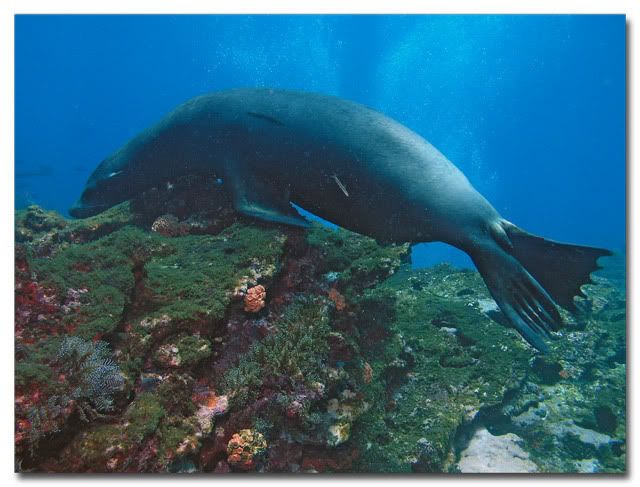
Sea Lion at Cousins Rock
Following the checkout dive, we had our welcoming champagne reception where we met the rest of the crew and then got underway for North Seymour Island. Early the next morning as I sat enjoying a cup of coffee in the salon, an announcement was made that there was a whale breaching off the bow. I made my forward to watch as the GA I cruised between two starkly beautiful volcanic islands. Dolphins were playing around the boat as frigate birds and boobies wheeled overhead. Periodically, a mobula ray would break from the surface, do a back flip and glide back into the water. I've had worse mornings.
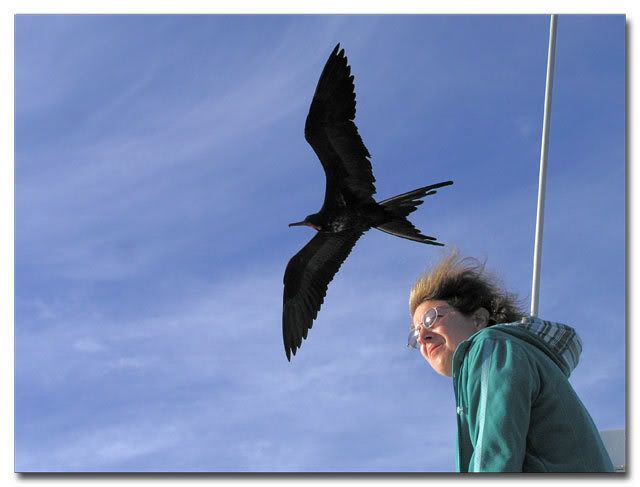
Kriss and a Frigate bird
Following a couple of good dives in the 71° F (22° C) water of N. Seymour, we boarded a panga for a shore excursion. Wandering amongst the marine and land iguanas, frigate birds looking for love, blue footed boobies, and sea lions and their pups, all of whom showed no fear of humans what so ever, was a wonderful experience. All too soon we had to re-board the pangas and head back to the boat for the eighteen hour crossing to Isla Darwin to begin our quest for Señor Grande.
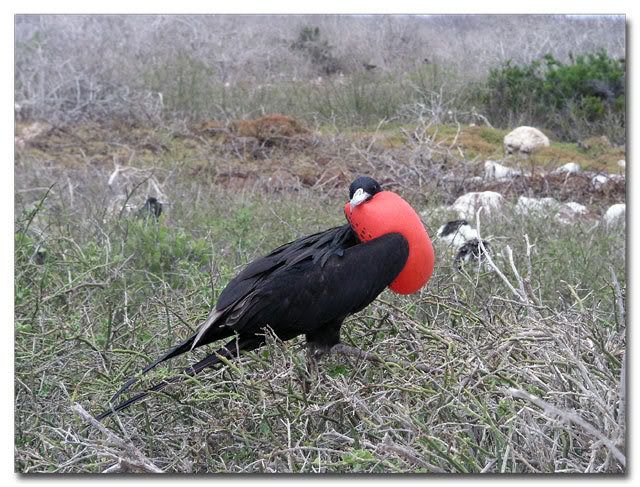
Frigate Bird - North Seymour Island
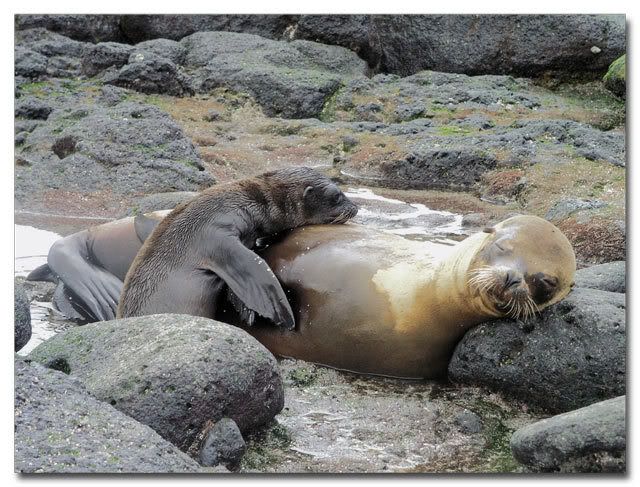
Sea Lion and Pup - North Seymour Island
Saturday morning we awoke to the sight of Darwin's Arch. During the dive briefing we were told that while the DM's might give a single bang on the tank to alert us to something mundane like a school of Hammerheads passing overhead, multiple tank bangs could only mean one thing; Señor Grande, Mr. Big, the Whale Shark. We dropped to about 80 FSW (24 meters) and wedged ourselves into the barnacle covered rocks to wait for some action. The first twenty minutes went by without a lot of activity, but finally we started getting some Hammerhead action. Then suddenly, BANG BANG BANG and Walter and Nelson were off like a shot. I was at the tail end of the line of divers. Like others before me, I had succumbed to the lure of elusive yellow puffer (technically, a Guinea Fowl Puffer fish - Golden Phase), and was distracted trying to get a photo. While I got close enough to clearly see the whale shark, I wasn't able to get a good photo. Kriss was much closer to the DM's and was able to get within about a foot of the shark. She said had to dodge the massive tail as the shark passed, and came within inches of joining the exclusive "whacked by a whale shark" club.
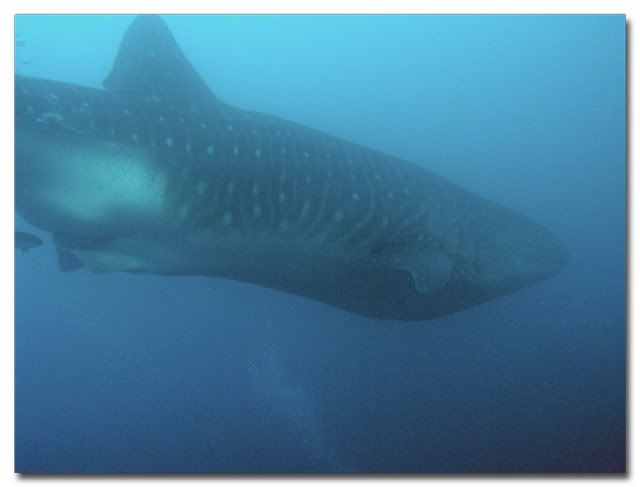
Mr. Big - Finally!
Kriss and I saw whale sharks, usually multiple sighting, on six of our eight dives at Darwin's Arch. Unfortunately, luck (ok skill), was against me and I was never able to get in position to get a really great photo (damned yellow puffers). On one occasion we had turned away from the rocks and were heading into the blue to do our safety stop when a whale shark came from out of nowhere and swam within a few feet of us. Of course I had been shooting some yellow puffers earlier and didn't have my wide angle lens mounted, but I was able to get a great shot of some gill slits! Sigh, I guess I'll just have to come back.
Kriss Swimming With a Whale Shark
Video by Nelson
As fantastic as diving with schooling Hammerheads, Galapagos, Whale sharks and yellow puffers was, Darwin's Arch had much more to offer. On one dive I was buzzed by a dolphin, my first underwater wild dolphin encounter. After surfacing from another dive, a large pod of dolphins swam along side us as we waited for our panga pickup. Various eels, King Angel fish, Moorish Idols, tuna and numerous other species abounded. While I was busy shooting a green turtle being cleaned by some King Angel fish, Kriss said she counted a total of nine turtles at one time in the rather limited vis. "It was a freaking turtle convention down there" was how she described it after the dive. Sadly, after two days, it time to leave Darwin's Arch.
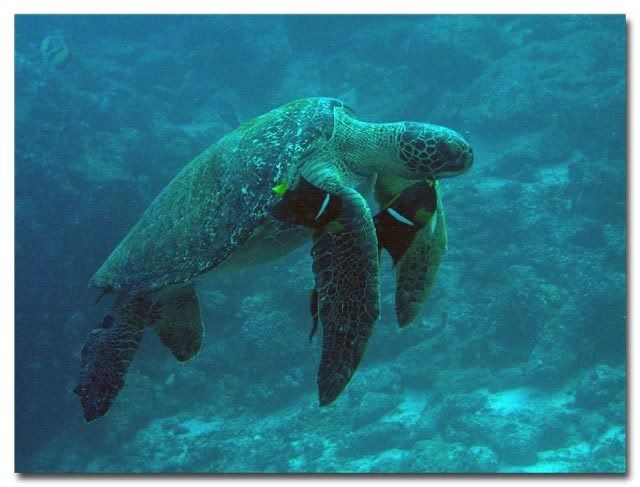
Green Sea Turtle being cleaned by King Angelfish
We spent the next day doing three dives on Wolf Island. While there was a fair amount of Hammerhead and Galapagos shark action, the DM's told us this was much less activity than usual, most likely due to the water warming up. The temps at both Darwin and Wolf were a constant (and toasty) 76° F (24° C) with no thermoclines down to at least 100 FSW (30 Meters). Still, the diving was spectacular with more dolphins, turtles, Leather Bass, Long Nosed Hawkfish, schools of spawning fish, and much much more. That afternoon we headed out for the long cruise south.
Tuesday morning found us at Cousins Rock, where it was time to end our quest for Mr. Big and enjoy some of the macro sights the Galapagos has to offer. This was to be a sea horse hunt, so everyone diving with a DSLR traded in their wide angle lens for their favorite macro lens. Of course as soon as we backrolled off the panga we dropped smack into the middle of an enormous school of Black Stripped Salemas that must have numbered in the hundreds of thousands, if not the millions. As we dropped through the mass of tightly packed fish, the highly polarized school closed around us and it became as dark as a night dive. For the first time of the trip I lost my case of DSLR envy as I attached my wet mount wide angle lens and started shooting away.
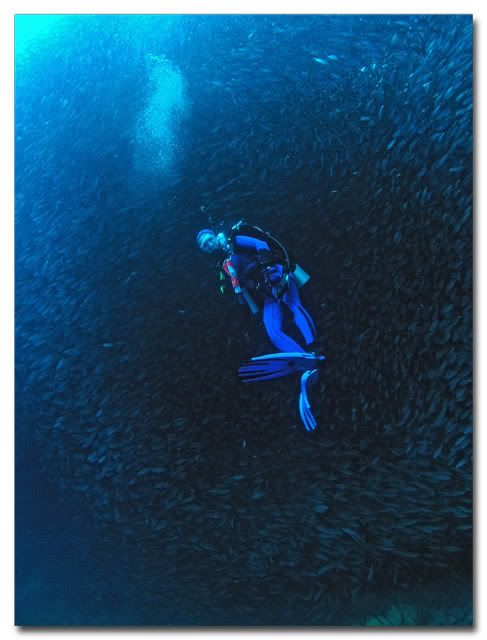
Kriss beside the Schooling Black Striped Salemas
At this point, I must interject my sole negative comment lest this report read like an old Skin Diver Magazine article. Shortly after leaving the Salemas school we started combing through the black coral looking for sea horses. About this time the GA II dropped their load of sixteen divers on the same location. Thirty divers trying to view and shoot a handful of sea horses became way too much of a zoo for me. Unfortunately, the exact same thing happened on our second dive as well. A little more coordination between the boats could have avoided this and would have been most welcome. Nevertheless, we managed to find a number of sea horses, which was not really too much of a challenge as these suckers were huge, and a frog fish as well. We also had a few sea lions performing for us and I actually manage to get some photos! (See Mike, I really did learn something).
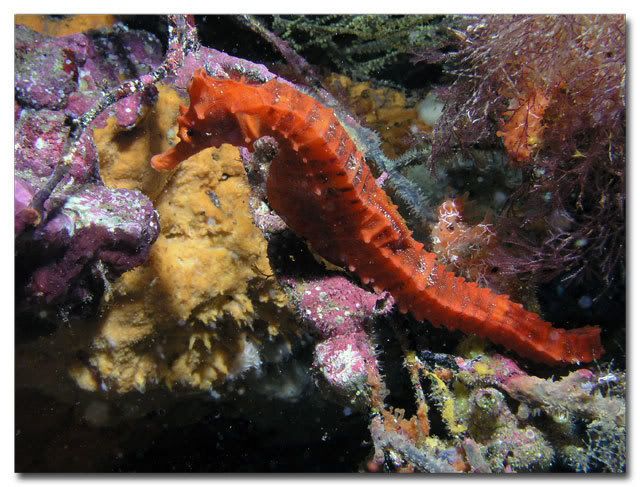
Sea Horse at Cousins Rock
That afternoon we were given a choice of a land excursion on Isla Bartolomé or another dive. Typically the dive isn't an option, but since so many dives were missed due the bug, an exception was made. About half of us choose to do the land excursion. The volcanic landscape was the feature of this trek. If you recall the movie "Master and Commander: The Far Side of the World", this is the site where Steven and Midshipman Reed spot the enemy French frigate (truth be told, except for the pinnacle scene, that was filmed in Baja California). Following the tour, we cruised around the island to see the equatorial penguins. After returning to the GA I, Kriss and I donned our wetsuits and went snorkeling in hopes to see some of the penguins in the water hunting. No luck with that, but we did manage to get a close up look at them on land and spot a white tip shark and some other interesting stuff.

Pinnacle Rock at Isla Bartolomé
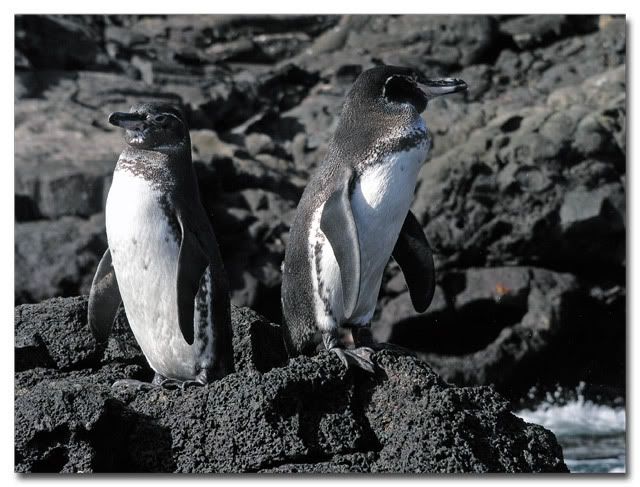
Equatorial Penguins
Wednesday morning found us at Gordon Rocks for our final dives. We had hoped to see some Hammerheads one more time, but luck wasn't with us. We did see a large school of King Angle fish and near the end of the dive Walter spotted a formation of three Golden Rays. Thanks to an absence of yellow puffers, I was able to join him and get a decent shot. After a short 30 minute SIT, we swapped tanks and did our final dive on Isla Santa Cruz directly from GA I. This was a final shallow sea lion dive. We headed to the right but not much was happening, so we turned the dive and finally found a group of about six young and extremely playful sea lions having a ball. They had collected a plastic ring, a feather, and a candy wrapper and were having a blast with them inventing sea lion games. At one point one inquisitive sea lion tried to eat my camera strobe (obviously no photo of that) while another was nuzzling Kriss' hood. All too soon we had to tear ourselves away from these delightful creatures and return to the boat, ending our last Galapagos dive.
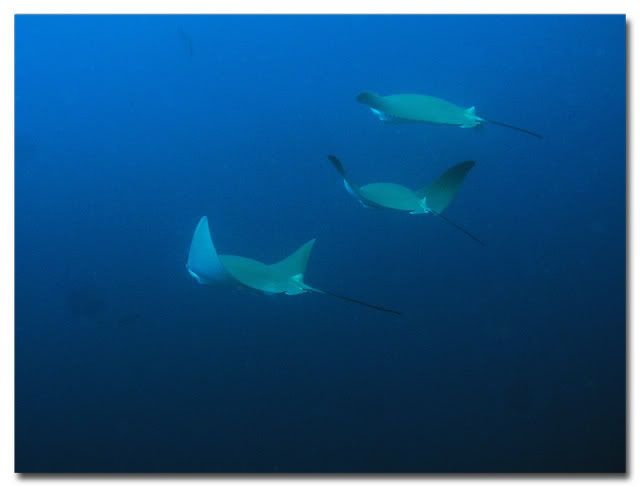
Golden Rays

Sea Lion at Gordon Rocks
In the afternoon we toured the Charles Darwin Research Center and had close up encounters with some of the various subspecies of Galapagos Tortoise, and then browsed the shops of Puerto Ayora, giving the crew a chance to re-provision the boat for the next weeks charter. That evening we had our end of trip cocktail party (well beer and wine anyway), viewed the fantastic video of the weeks diving shot by Nelson and Walter, and had our photo school graduation ceremony. We also received our trusty shellback certificates commemorating our crossing of the equator at sea, which thanks to our strict sexual harassment policies, won't be gracing the walls of my office during my lifetime.
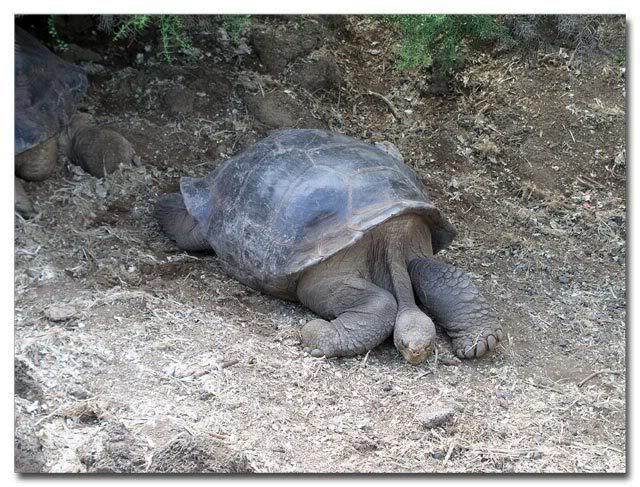
Sleepy Tortoise
The next morning found us back in San Christóbal where Nelson and Walter escorted us to the airport. Of course our AeroGal flight was late, no doubt due to the weather in Quito, but eventually we made it to Guayaquil, were we parted ways with our new friends. Due to our frequent flyer schedule we had a couple of days to tour the sprawling city of Guayaquil, but soon after checking into our room at the very nice Hampton Inn, Kriss rapidly developed symptoms of the bug that had laid low most of the other passengers. They bug kept her down, (or maybe I should say up and down) for about 24 hours, but she recovered quickly and we spent our final day visiting some of Guayaquil's many museums and traipsing through El Malecón, the beautifully redeveloped waterfront along the Guayas river. A couple of restaurants we hit worth noting are Casa Baka, a Spanish Restaurant with a Basque flair, and El Characol Azul, specializing in Peruvian style seafood. Both are highly recommended.

Marine Iguana
The Jim Church School of Underwater Photography
For the past five years or so, Mike Mesgleski and Mike Haber have been teaching underwater photography aboard the Aggressor Fleet under the name of the Jim Church School of Underwater Photography. This particular trip was billed as a photo expedition. The only difference between an expedition and a course is the amount of in-water assistance you will receive due to the diving conditions. The excellent topside instruction remains the same. Due to relatively small number of passengers onboard the GA 1, only Mike M was on board this trip. Usually both are present. The class was informative, humorous and well balanced given the differing skill levels of the students. Photo critiques were helpful and Mike could usually find something encouraging to say about even my worst mistakes. During the week we heard tales from some of the other passengers about other classes they had attended taught by overbearing photo nazis. They sounded like an absolutely perfect way to spoil an expensive vacation.
Whether you are a new U/W photographer just getting started, or an experienced one looking to improve your technique, I can definitely recommend taking a course with Mike and Mike.
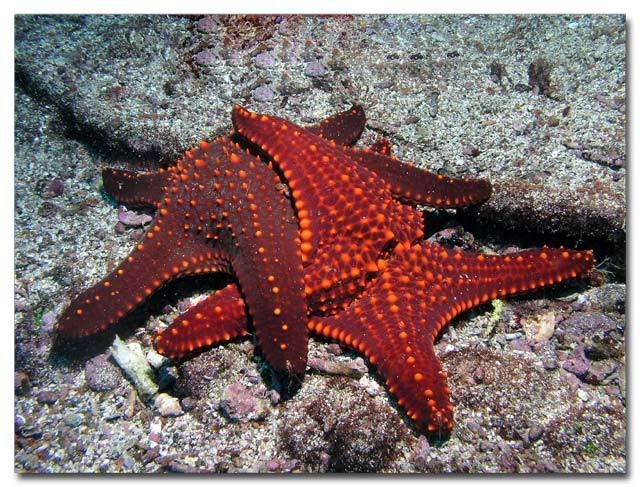
Starfish Friends
Ecuadorian Essentials and Miscellaneous Tips
Or Stuff You Ought to Know
In 2000, Ecuador adopted the U.S. dollar as their currency, though you may receive change in Ecuadorian coin. If you ever wondered what happened to all those Susan B. Anthony Dollar coins, you'll know after your trip. Outside of the big hotels and tourist areas, your dollars tend to go a long way. Take lots of $1 and $5 bills for tips and cab fare (cabs are cheap, but set the price in advance). Unlike a lot of popular dive destinations, outside of hotels, English is not spoken by the vast majority of locals and having some conversational Spanish really helps. I'm certainly motivated to improve mine now. Ecuador is on Eastern Standard Time (GMT-5) and does not observe daylight savings time. Galapagos is GMT-6. Crime can be a problem and I'd advise reviewing and heeding the State Department's Consular Information Sheet and taking other appropriate precautions.
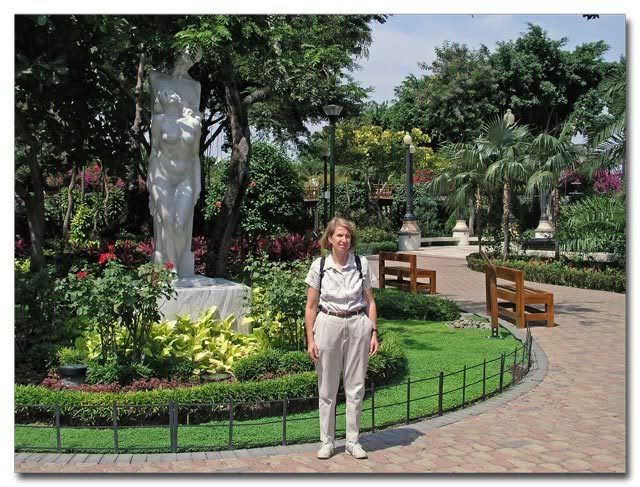
Kriss at the beautiful El Malecon waterfront park in Guayaquil
Be prepared to pay a $100 Galapagos Park entry fee (cash only), a $70 port tax, $25 to $31 departure tax, and 12% sales tax on purchases. Thankfully, no fuel surcharge was assessed.
Kevlar gloves should be considered an essential. The rocks at Darwin's Arch are covered with razor sharp barnacles and depending on the current, you may be holding onto them for dear life. Quito is more than 9000 ft. (2750 meters) above sea level and can get chilly, as can the GA 1 after several cool water dives. We took some lightweight fleece jackets, and were glad we did. I did lots of 1000 meter sprints in the pool with mask, snorkel and fins to get in shape for chasing down Señor Grande - I should have done more. Follow the yellow tank - not the yellow puffers.
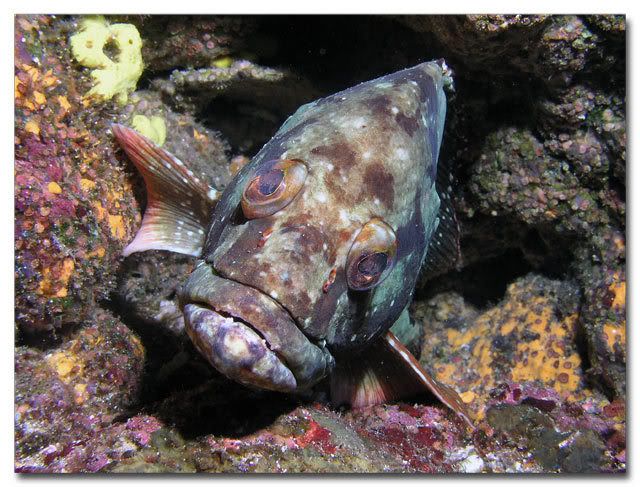
Grumpy Fish
Conclusion
Or Thank goodness he's almost done.
Or return home was largely uneventful with the exception of one rather humorous incident the Newark NJ airport. We had cleared immigration and customs and were reentering the secured area of the terminal. As Kriss' carry-on bag with our regs, and my camera bag passed through the x-ray machine, the TSA agent shouted that she needed a hand search on two bags, something we are quite used to. Another TSA agent took us and our bags aside and when he opened Kriss' bag and saw the regs muttered "oh, divers". He then opened my camera bag, removed my copy of Galapagos - A Natural History, which he held in his left hand while pawing through my camera gear with his right. "Where have youse guys been diving?" he asked. Awed by his amazing deductive skills, I replied "Umm - the Galapagos Islands". "THE GALAPAGOS, AREN'T THEY SHARK INFESTED?" was his incredulous response. To which I could only reply "Hell yea, that's the reason we went!"
The look he gave us was pure "These people are Absolute Nuts." Absolute nuts we might be, but we had been diving our dream. We will be back.
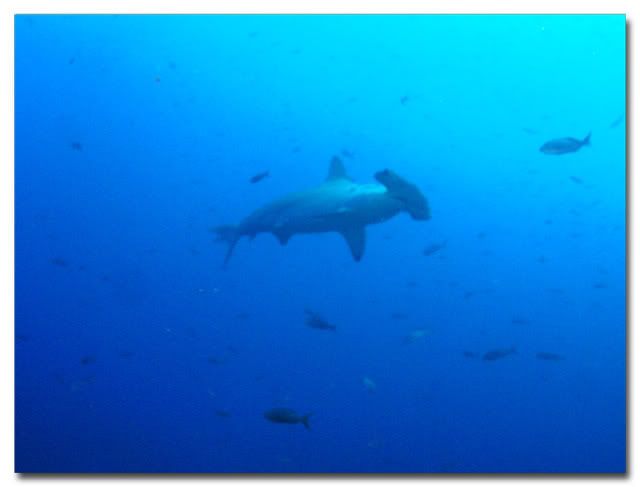
Hammerhead Shark
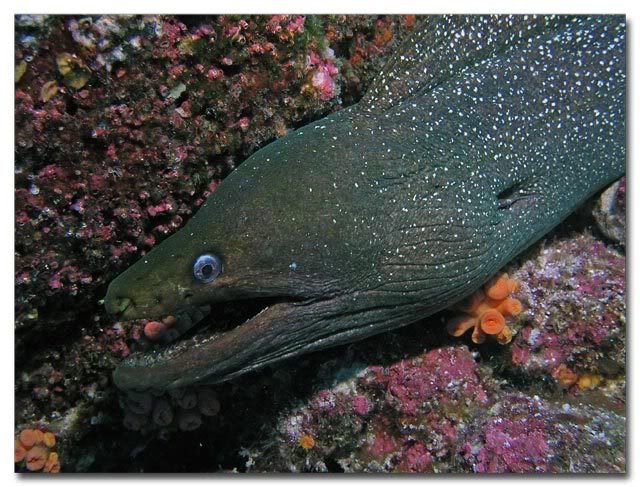
Fine Spotted Moray Eel
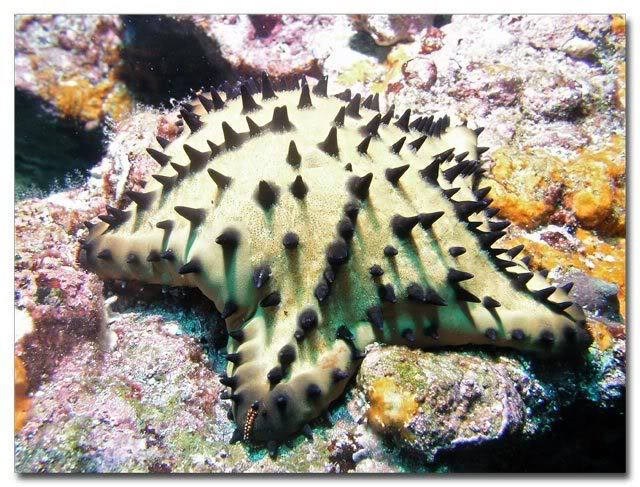
Chocolate Chip Starfish
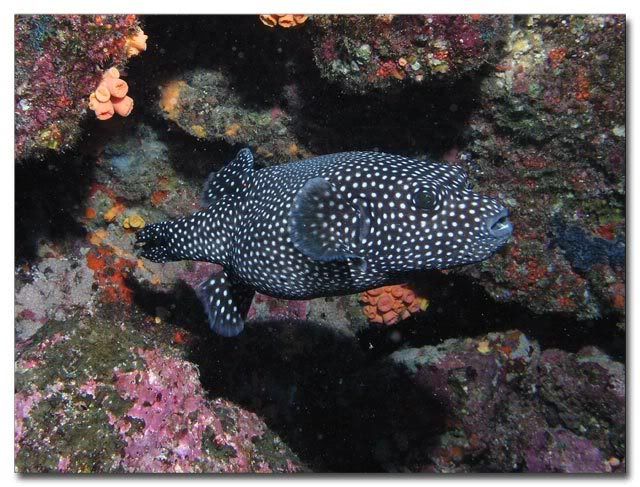
Guinea Fowl Puffer
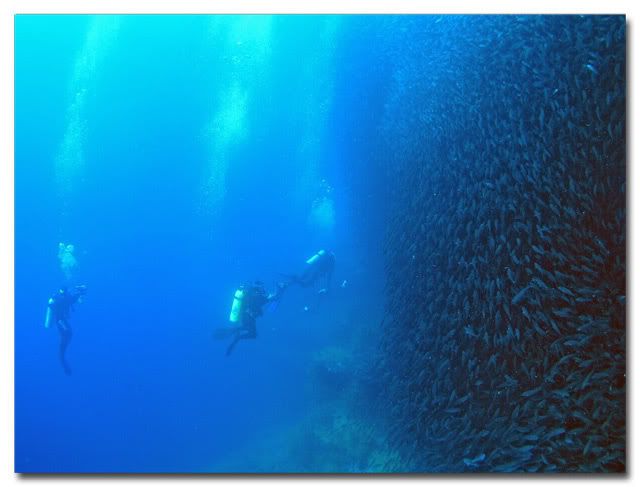
That's a lot of fish! Salemas School
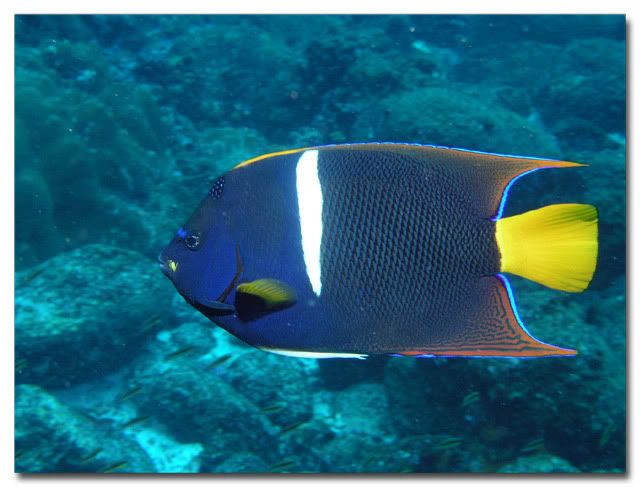
King Angelfish
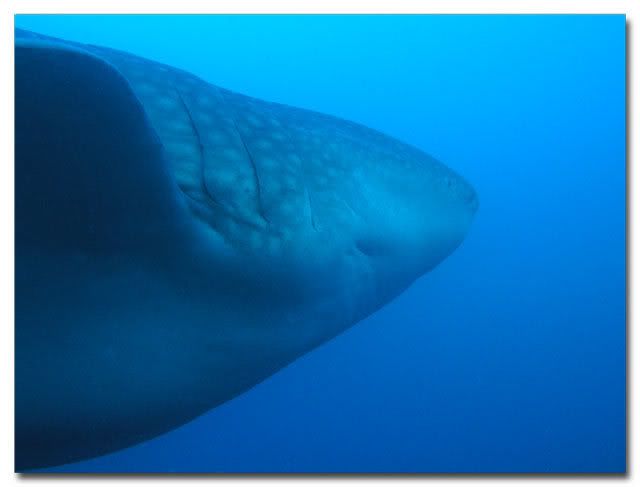
It's either a Vogon from the Hitchhikers Guide or a Whale shark's gill slits
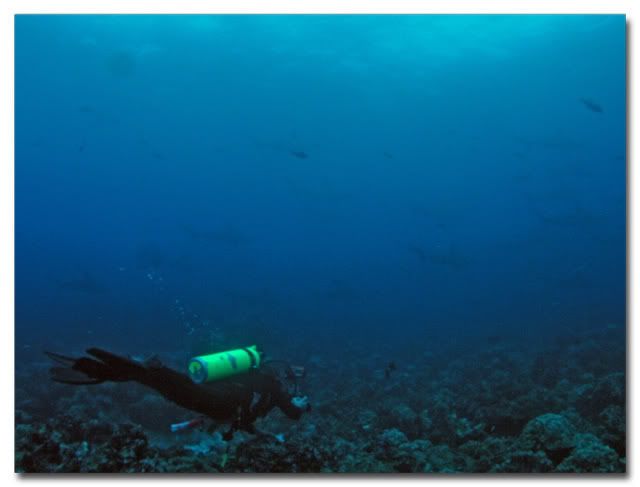
Follow the Yellow Tank
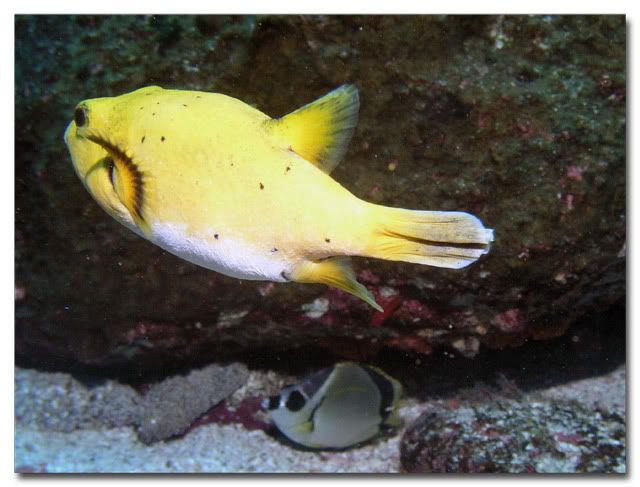
Not the Yellow Puffer!